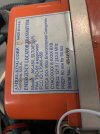- Joined
- May 24, 2016
- Messages
- 958
- Display Name
Display name:
4RNB
I am considering some international travel. My reading states ICAO requires elts the transmit on 121.5 and 406 mhz. How do I figure out if my elt qualifies? Are the frequencies published on data plates?
2009 vans rv10 if it matters, thumbing thru all the records without success so far. “Ameriking” is all I am seeing.
2009 vans rv10 if it matters, thumbing thru all the records without success so far. “Ameriking” is all I am seeing.


